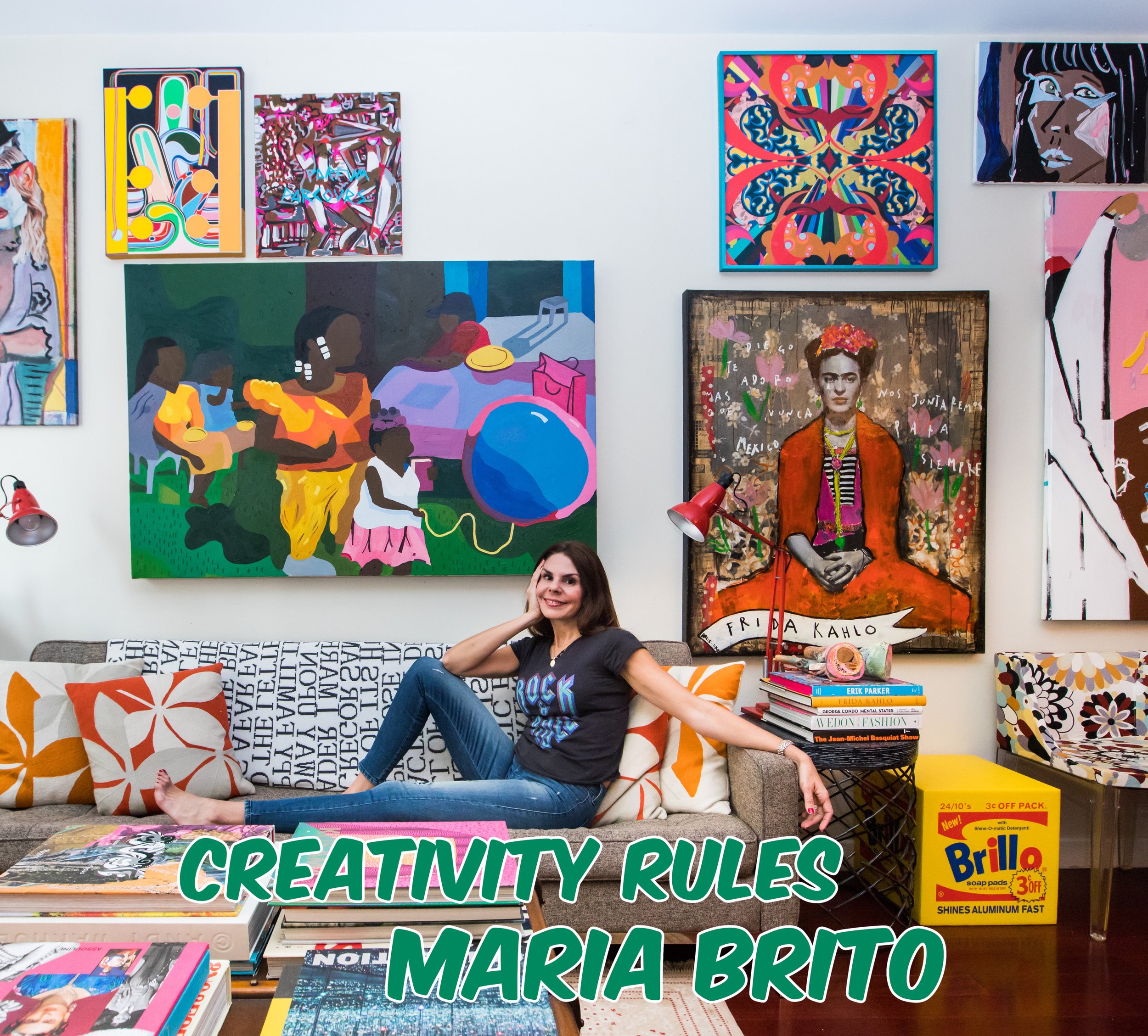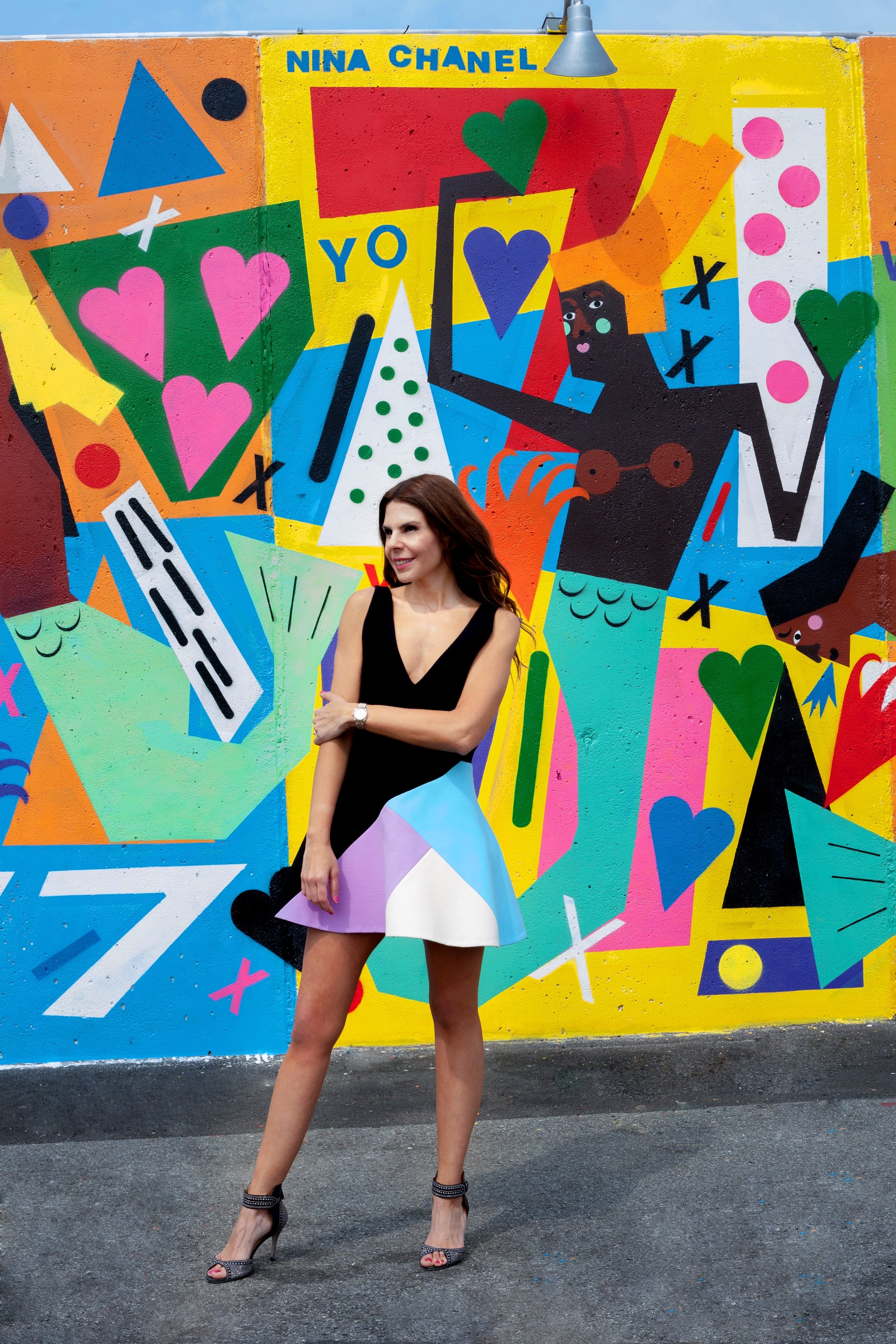A few years ago, we had the pleasure of meeting Maria Brito who is an award winning NY based contemporary art advisor, author and curator. She is known as a Power Players in the Art World and in 2020 she was named by ARTNEWS as one of the visionaries who gets to shape the art world. With her finger on the pulse of noted and rising artists, we wanted to catch up with her to talk about how she came to this industry, what it's like to build a personal collection versus when she is working with her clientele who includes A-list celebrities, demistifying art, the impact of NFTs on art, what her Art Basel experiences are and finding out about her book which is available next month!
ATHLEISURE MAG: You are a noted and well-respected power player in the art world. Prior to working in this industry, you graduated from Harvard Law School and practiced corporate law for a period of time. How did you come to the world of art and realize that this was an industry that you wanted to work in?
MARIA BRITO: I grew up in a family that prioritized art as a cultivation tool, like a hobby, but not a career. I went to every art exhibition, museum, gallery and artist studio my parents took me to, and it was really a very hands-on training for me. I continued furthering my passion when I moved to New York City in 2000 as a newly-minted attorney and started going to galleries and buying for myself.
AM: When you began building your personal collection of art work, what were you drawn to initially?
MB: I have always been drawn toward figuration, the human form, saturated colors, narratives that move me. I started collecting the work of Black artists way before all the galleries went crazy for them in the past 5 years. I am very proud of that.
AM: Can you tell us the difference between being a curator and an art advisor and why you love working in these areas?
MB: An art advisor is someone who makes suggestions as to what to acquire and why. It brings access and an eye to a client and it’s the eyes and ears of the art collectors who can’t possibly navigate the art market which is a global $300 billion market. A curator is someone who makes sense of how a collection looks together or envisions an art exhibition that has a theme that is coherent. The curator is an editor, the advisor is a strategist.
AM: Why is the concept of buying art and ultimately curating a collection intimidating to those that are outside of the art world?
MB: I think for too long people have had the wrong idea because what gets written in the big newspapers or reported on mainstream TV are the insanely high numbers that happen when a piece of art sells at auction for $200 million - that is intimidating. Or when people go to a gallery and the environment feels sterile and impersonal - that is intimidating. But that’s just the surface, there are thousands of galleries around the world as well as websites and art fairs that sell art priced under $5000 - people have no problem saving up money to buy a handbag for that amount of money or more. But a piece of art bought with a little bit of an understanding of the market can not only multiply its value 100x but also stay with you forever.
AM: How do you demystify the experience so that it’s more approachable to those that want to obtain art for their pieces?
MB: As I mentioned above, there are all sorts of levels in the art market. People take bets in emerging artists because they see the potential. There has never been a better time to collect or to be an artist. Besides, it’s all a cultural dialogue that is formed between the art and the collectors.
AM: I know that you have been an art advisor to Sean Combs, Gwyneth Paltrow and Tracy Anderson – what is the client relationship like in terms of making them aware of pieces, educating them about collections and ensuring that that it meets the requirements that they are looking for?
MB: I have hundreds of clients and they are all important to me. Every client gets a tailored approach with offerings that resonate to who they are and what moves them. That happens because I spend a really good amount of time getting to know my clients’ tastes and their objectives.
AM: Art Basel took place a few weeks back, what’s that time of year like for you and can you give us insight into how you navigate this show personally as well as when you’re doing it with/for your clients?
MB: That’s the busiest and most intense time of the year. It’s an insane amount of work because physically you have to go not only to Art Basel which can easily take 4 or 5 hours to see but to all the satellite fairs like NADA and Untitled which is where all the new talent gets to be shown. Clients come and walk around the aisles with me but the thing is that for the most part almost all of these galleries have circulated PDFs with all the images and the previews of what they will be showing so much of the good stuff has already been sold. That’s why an art advisor is so important for people who want to collect if they can’t dedicate themselves to building all these relationships with galleries.
AM: You curate art shows such as Greek Gotham in Mykonos a few years back with NY based artists such KAWS, Nir Hod, and Erik Parker, what do you look for when you are putting shows together like this?
MB: First I have an idea and then I let the idea marinate inside my head. Then I discuss it with the person who hired me to do the exhibition and then I go for the most talented artists I can approach who actually fit the idea or theme I had.
AM: How do you keep your pulse to the ground in terms of finding new artists and phenomenal pieces?
MB: By pounding the pavement! It’s easy to get complacent and more so now in a world that has gotten so digital but I still go to as many art galleries as I can every week, every art fair I can attend and artists studios when I can.
AM: Your firm Maria Brito LLC, includes your work as an advisor, but it also includes being an interior designer which seems like a natural progression with lifestyling as well as your fashion accessory design collaborations. Tell me about your firm and what your day-to-day is like.
MB: I actually don’t do interior design anymore because as a creative entrepreneur I know when to pivot - that business is good for the money but my mission in this life isn’t to place rugs in people’s homes. With accessories that was a very fun time but I did it for several years as an extension of my relationships with the artists and because there was nothing like it in the market. However, when my advisory practice grew and grew, and the headaches with factories and retailers also grew, I knew it was time to end that too. I still get called to consult with companies on product collaborations and I do that from time-to-time. Last year I launched two fine-porcelain collections with Showfields in collaboration with artists Cydne Coleby and Allison Zuckerman.
AM: Last year, NFTs became the conversation across all sectors of business. What does it mean to the art world and how are you navigating NFTs with artists you work with and clients that you curate/advise for?
MB: NFTs are a very important development in terms of digital ownership and because society is moving more and more toward a digital world, this movement found the perfect timing to flourish. Like everything that's new, right now it’s a lot of confusion, gray areas, speculation, like the wild west. My clients mostly collect art that is tangible, to live with in their homes or their offices, so while NFTs are a lot of fun, they will never replace physical art.
AM: Who are 3 artists that are currently on your radar that you’re looking at that we should be aware of?
MB: Cydne Coleby, Ryan Wilde and Cristina BanBan.
AM: Next month, your book, How Creativity Rules the World: The Art and Business of Turning Your Ideas into Gold drops. What was your motivation behind writing this book and what is it about?
There has never been a more crucial time than now to develop your creativity and your ability to innovate. Coming up with original ideas of value is today’s most precious skill.
MB: I wanted to debunk the myth that creativity is only for the few chosen ones or that it is genetic. Creativity is not about arts and crafts and cutouts or technical wizardry. Creativity is about fostering specific habits, making associations, and standing behind the ideas that come out of them. Whether you are an entrepreneur, an artist, or an employee, your creativity will help you turn the mundane into the extraordinary.
This is a book that helps leaders access their creative potential and profit from their ideas. It took me 13 years to be able to gather all the information that is here, and it’s a comprehensive, practical and actionable blueprint that will get you there even if you don’t think you can be creative and innovative.
I used every technique and everything that’s in this book to transition from a miserable corporate attorney to building an industry-leader seven-figure art advisory business and I have taught the same methods to people in companies as well as to hundreds of entrepreneurs, freelancers, managers, and artists through my online program Jumpstart.
I know these methods work and the time was right to bring them to a greater group of people through a book that is timely and timeless.
AM: Are there any projects that you’re working on that we should keep an eye out for that you’re working on?
MB: Writing a book, selling it at auction to a major publishing house and launching it is like having a full-time job on top of your full-time job. The book is the biggest project that I have worked on in a long time.
PHOTOGRAPHY COURTESY | Maria Brito
Read the FEB ISSUE #75 of Athleisure Mag and see CREATIVITY RULES | Maria Brito in mag.








